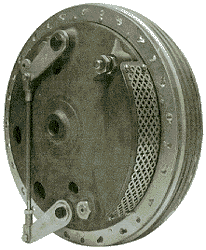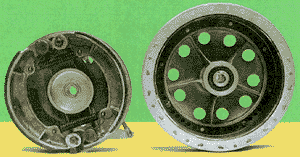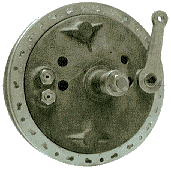
The following is taken from an article entitled, "ITALIAN COMPETITION BRAKES" written by GIANNI PERRONE. I wish to give the author full credit for his wonderful work, and am only reprinting this material to make it accessible to more motorcycle enthusiasts.

The Oldani 200-mm dual-cam front brake weighed only 4.9 kg (1963). The price at the time was 37,000 liras.
As far as I can remember, the first brakes at a craft level were those produced by Oldani (father and son) in Milan and by Salvai in Turin.
Gaetano Oldani started out by assembling bicycle wheels in a small workshop in via del Moretto in Milan. His second step was to modify the brake-shoes that passed through his hands, enlarging them and fitting them with linings made with his own secret compound; later he produced his first racing wheel. This had a 250 mm hub with a single cam brake, and, for its time, it was very efficient. In a short time it was mounted on various production bikes, such as Matchless and Norton ex-military bikes which were modified in those times for racing, and also on the Guzzi Condor and Norton Manx, which were already equipped with quite efficient and light competition brakes. Oldaniís brakes were better, particularly in their resistance to fading. Soon all the most famous English riders, Hailwood, Minter, Hartle and McIntyre fitted Oldani brakes to their Nortons.
The smallest model, the 180 mm, was adopted for all the Mondial racing bikes, whether for sport or Grand Prix; with the latter Oldani won the World Championship for 125 and 250 classes in 1956 and 1957.

Totally cast in magnesium alloy (elektron), the 200-mm Oldani had an internal cast-iron ring insert on which the shoes worked during braking (effective width 30 mm).
Moto Morini also adopted Oldani brakes for its competition bikes: the large ones for the Grand Prix 250 (including Proviniís) and the smaller ones for the 175 Settebello. The last series of Settebellos, the famous "short pushrods", were delivered with Oldani front and rear brakes.
Over the years Oldani modified his product; first putting fins on the central part of the drum to improve fade resistance and to overcome the major defect of his hubs which was that the cast iron insert in the hub might crack.

Oldani single-cam rear brake.
The second and more important modification was the double cam. The cams were connected by a steel rod provided with threaded adjusters. The adjustment of the brake cams was extremely important because the Oldani brakes could not be modulated very much and it was a common occurrence for the wheel to lock on being braked hard at low speed. For this reason the back brakes were produced with single cams.
In time these shortcomings were corrected and the efficiency of the brakes improved due to a further improvement in the linings. Oldani never produced double shoeplate brakes, as Ceriani and Fontana did, but he was studying them when the company ceased operating.
![]()